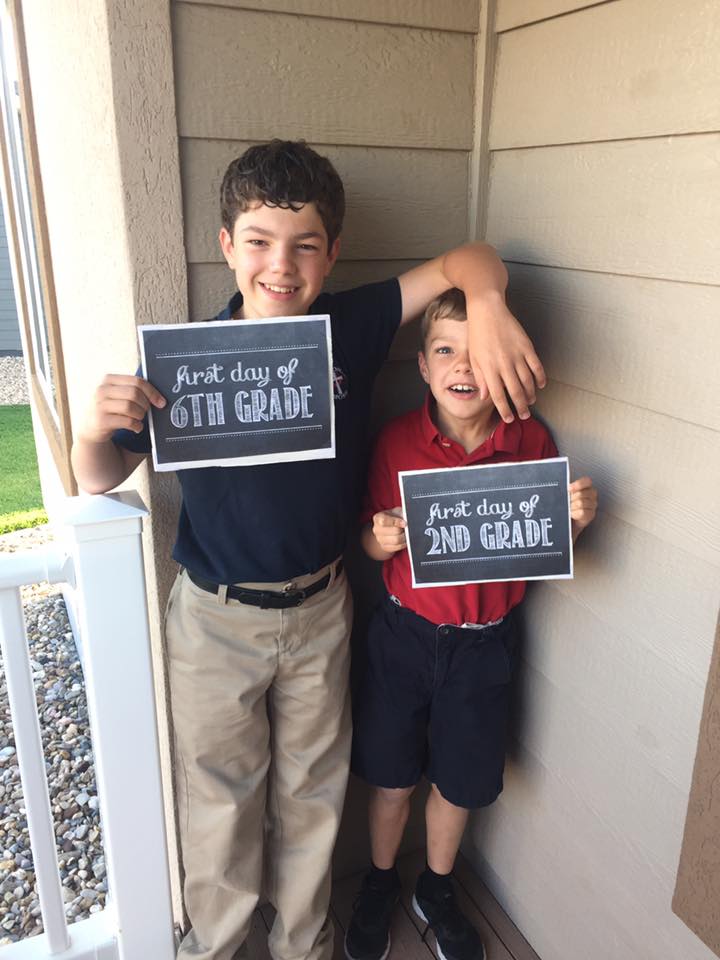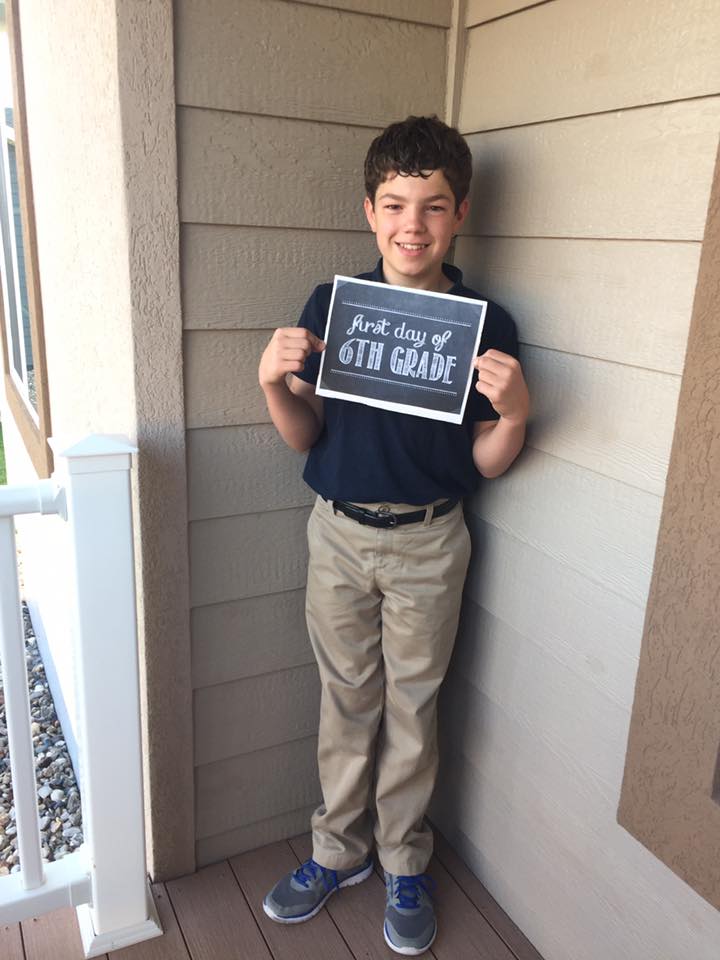All grief carries a loneliness, but there is a particular loneliness for men. In times of loss, men are asked, “How is your wife? Your family? Your kids?” Rarely does someone come shoulder-to-shoulder to grieve alongside a man.
Why I talk about my dead child on social media
I know, it makes many of you squirm a little…or maybe even a lot. It’s uncomfortable. Our society doesn’t do death, or pain, or life-changing grief, so we follow the crowd and look away. Pain that can’t be cured is like leprosy…it must be pushed aside, driven to the outskirts and left to fend for itself. Society teaches us that it’s acceptable to rally around the child fighting cancer. We all get warm-fuzzies in supporting that family and that child in their fight. It feels good to support a cause like that, but when death wins that battle we quickly drift away. What society does not teach us is how to be present to a pain that can’t be cured. It’s too hard. It’s awkward. We don’t know what to say. The reality of a dead child is too much to bear, and our culture encourages us to bring a casserole and then carry on with our lives, not daring to take the time to truly peer into that grief.
So, when I talk about my grief and the child that is no longer in my arms, it’s often easier to pass by the post without acknowledging. We’d much rather protect ourselves from the reality of unjust tragedy, however, that tragedy is now my world. I can no longer look away. When I share my world, it’s easier for others to wonder if I’m stuck in my grief, if I’m seeking pity or attention, or if I’m broken forever, than it is to imagine a pain that deep. Society implies that if we openly express our grief, we are immature, needy, or we simply can’t cope with our grief...so it’s easy to assume that I must be doing something wrong.
The truth is, expression of my grief is the work of mourning. There are so many thoughts and emotions bottled up inside of me that I have to get them out! That is exactly what mourning is; it is the outward expression of my grief. This mourning, this outward expression, is not just a small part of the grieving process, it is ESSENTIAL to it. I’m not making my thoughts about my broken heart and my dead child public because I’m stuck; I do it because I’m healing. Alan Wolfelt, a leading grief teacher and expert points out, “ Mourners who continue to express grief outwardly are often viewed as ‘weak,’ ‘crazy,’ or ‘self-pitying.’ The subtle message is ‘Shape up and get on with your life.’ The reality is disturbing: Far too many people view grief as something to be overcome rather than experienced.”
When I talk about my child, I am doing my grief-work. My world has been torn apart. Nothing makes sense anymore. My feelings, and emotions, and the chaos in my head are overwhelming to me, too. But the thing is, that chaos is normal for someone who is grieving. While anyone who has grieved intensely will tell you how normal that “crazy” feeling is; yet it feels anything but normal to me. I need to be affirmed in my feelings and to be reminded that I’m not as crazy as I feel.
I tell you about my dead child because telling my story helps close the gap between my head and my heart. My head knows that my child is no longer here. That he is dead. My heart can’t possibly bear that. My heart has dug in its heels and refuses to come along on this ride. I must coax it gently into this new world that my child is not a part of.
I know, my mourning makes you feel helpless and no one likes to feel that way. In order to heal from my hurt, first I have to explore the depths of it. As Alan Wolfelt puts it, “To honor your grief is not self-destructive or harmful, it is self-sustaining and life-giving!” I need to know that there is good reason for the depth of my pain and I need to be affirmed that the loss of a child arguably the most painful loss that can be endured. I need to know that every sting, ache, stab, crippling pain, and unexpected flood of tears is acceptable and normal. Please don’t tell me not to grieve, or not to cry. Don’t encourage me to “be strong”, or to pick myself up and carry on. The most helpful thing you can do for me is something our culture teaches us to run from. If you want to help me heal, then sit with me for a moment in my sorrow. Be brave enough to feel my pain for just a moment. I need to know that while the depth of my pain is as it should be, and then you may gently remind me that I won’t always hurt so fiercely. Remind me of the hope for meaningful life to re-emerge and that joy won’t always be lost in the shadows. But as you give me that reminder, I ask you to remember to hold space for my sorrow. I will heal, but I will never be the same. I will experience joy and laughter, but it will always be tangled with the strings of sorrow.
The grief work after the death of a child is a lifelong job. Yes, it will be most intense in those first years, but it will need to be re-visited regularly for the remainder of my existence.
Please be patient with me while I mourn. Share my pain with me for just a moment, in those times that I reach for comfort. Every time you see a post that makes you want to look away, don’t see me as weak and needy. Instead, dare to see my courage. Know that in my weakness I am being strong and courageous. It takes tremendous energy and courage to stare into the depths of my pain. Some of the world most beautiful people and missions are a result of intense sorrow. So remember that by giving my attention to those ashes, I am cultivating ground that can allow something profoundly beautiful to grow.
On the first day of school...I miss you
Family is Forever
One of the pieces for me to figure out after Lach died is how to acknowledge his place in our family without him here. I didn’t know other people who had pictures of their dead children on the wall. Is that poor taste? Is that clinging to something that I need to move on from? Should I hold on to him and his place in our family, or is that morbid? Am I honoring him by making a point to keep him as part of who we are, or am I a crazy lady who can’t let go? How do you integrate a deceased child into the life of your family in a way that is healthy?
Different people have different needs and will come to different conclusions on those things. The way I see it, even death does not change the makeup of a family. It may change the way a family looks and it may change the way the family functions, but it does not change who belongs. I wouldn’t think twice about a picture of deceased grandparents on the wall. It is an acknowledgement of people who were loved and a recognition of where we’ve come from. A picture of a deceased child is really no different. We keep Lachlan as a part of who we are by keeping his pictures up along with the rest of them, by openly talking about him in our day to day conversation, and by keeping him in our prayers at night. I hope that by doing so, it sends the message to my other children that they, too, are so important to me that not even death can take away their belonging here.
I do my best to honor Lach’s place without letting him run the show…just like I do with each of my other children. We have days and times that more attention is devoted to him, and other times when he falls to the backdrop. Sometimes there is more discussion of Lach, we stop to note his birthday and his angelversary, and he is included in our Christmas celebrations and twice a year we take a time-out in the other things we’re doing to put on what is often referred to at our house as “Lach’s run,” aka Run for Their Lives!.
Life is a balance of holding on and letting go. I hold on to Lach’s picture, but let go of the fact that he won’t grow with the other kids. I hold onto including him in our Christmas celebrations, but let go of not getting to see his eager smile as he opens his gifts. I hold on to the legacy that he left here, but let go of the fact he didn’t get to create that legacy himself. I hold on to knowing that he is part of our family forever, but let go of having his physical presence in our midst.
What Heals You?
Carly Marie, the woman who organizes this project, says “Turning the WHY into What Heals You? has been one of my greatest healers. Whenever I found myself asking “why did this have to happen. Why me? Why him?” etc etc I started asking myself what heals me?” She became aware that it was in intentionally turning to what was healing that allowed that process to unfold.
I’ve asked myself that similar question regularly, and I often ask it of newly bereaved parents too. What brings comfort? What helps? There is no ONE thing that is the mainstay of healing after the death of a child. It comes in tiny bits from many different places. The things that are the main pillars of my healing will not necessarily be what the next person needs. If you are close to a griever, you don’t have to just wonder what might help. If you ask them what you can do for them, or what they need, they’ll most likely come up blank. However, if you ask them what helps and what brings comfort, there’s a good chance you’ll get some ideas you can work with.
For me, the list of things that brought comfort and healing is something like this: talking with bereaved mothers, reading and journaling, building a legacy for Lachlan, planting a garden for him, talking with friends who weren’t afraid to hear, offering random acts of kindness to others. Being able to talk to the people at his daycare who answered questions about his last day. The steady presence of family. The people who reached out to us to offer their support whether by card, attending his services, donating vacation hours or cash to his memorial fund, or helping with household jobs was all very humbling and comforting. Finding ways to let my loss bring comfort to others who are on the same path. Knowing that Lachlan and his story has somehow made a difference in someone else’s life. Prayer and an intentional effort to grow my faith and deepen my relationship with God. My rainbow babies, who have brought more purpose, love and joy into my days. Being able to talk about it with my husband, the only other person on the planet that loved him and misses him like I do.
I’m not sure that true healing after the death of a child can happen without some sort of intentional movement toward that. Healing work is sometimes uncomfortable and difficult. I work in surgery, so I am reminded of the surgical wound that just won’t heal. Sometimes you have to intentionally work at getting a wound to heal and it doesn’t just happen automatically with the passage of time. It is uncomfortable, difficult, and time consuming, but you can’t ignore it. If you do, the skin might seal shut, but it leaves the perfect place for an abscess to form. The problem will not be laid to rest until it is dealt with. In order to get those tough wounds to heal properly, you have to pack it, debride it, and let it heal from the inside out. The loss of a child is like that. It is a wound that has to be healed from the inside out in order for wellness to be restored. Sometimes things like talking about the loss in a real way, or working through this project are emotionally draining, uncomfortable and take work, however, when you look back at it, you find that there is healing that happens on a deeper level and a lasting peace that comes from it.
Brave Enough to Face the Darkness
"Sudden and tragic loss leads to terrible darkness... The darkness comes, no matter how hard we try to hold it off. However threatening, we must face it, and we must face it alone... I had a kind of waking dream shortly after [the darkness set in]...I dreamed of a setting sun. I was frantically running west, trying desperately to catch it and remain in its fiery warmth and light. But I was losing the race. The sun was beating me to the horizon and was soongone. I suddenly found myself in the twilight. Exhausted, I stoped running and glanced with foreboding over my shoulder to the east. I saw vast darkness. I wanted to keep running after the sun, though I knew that it was futile, for it had already proven itself faster than I was. So I lost all hope, collapsed to the ground, and fell into despair. I thought at that moment that I would live in darkness forever. I felt absolute terror in my soul...
The quickest way for anyone to reach the sun and the light of day is not to run west, chasing after the setting sun, but to head east, plunging into the darkness until one comes to the sunrise.
I discovered in that moment that I had the power to choose the direction my life would head, even if the only choice open to me, at least initially, was either to run from the loss or to face it as best I could. Since I knew that the darkness was inevitable and unavoidable, I dicided that from that point on to walk into the darkness rather than try to outrun it, to let my experience of loss take me on a journey wherever it would lead, and to allow myself to be transformed by my suffering rather than to think I could somehow avoid it. I chose to turn toward the pain, however falteringly, and to yield to the loss, though I had no idea what that would mean."
-Jerry Sittser, A Grace Disguised
When I read this, it really struck a chord with me. In the wake of losing a child, there is so much uncertainty and fear. At the time, I would have preferred for my life to have ended with Lachlan's, but because broken hearts still beat, I had to make the choice to walk toward the east in hopes of eventually coming into the light.
This picture, to me, represents those moments when you find a tiny bit of light in the darkness, a ray of hope that eventually the sun will rise and that we will be able to regain some peace and joy. That despite the loss we can find meaning and purpose in life again. That is part of why I chose to start Lach's Legacy. Those glimpses of light brought hope and encouragement for me, and I wanted to be able to share that light and hope with other families who have suddenly found themselves in that all-encompassing darkness. All I have to offer is the tiniest bit of direction on where I found those rays of light on my journey. My prayer is that other families will find comfort in some of the same places that I did, and that the tiny bit that I can offer will somehow bring a glimpse of hope for them too.











